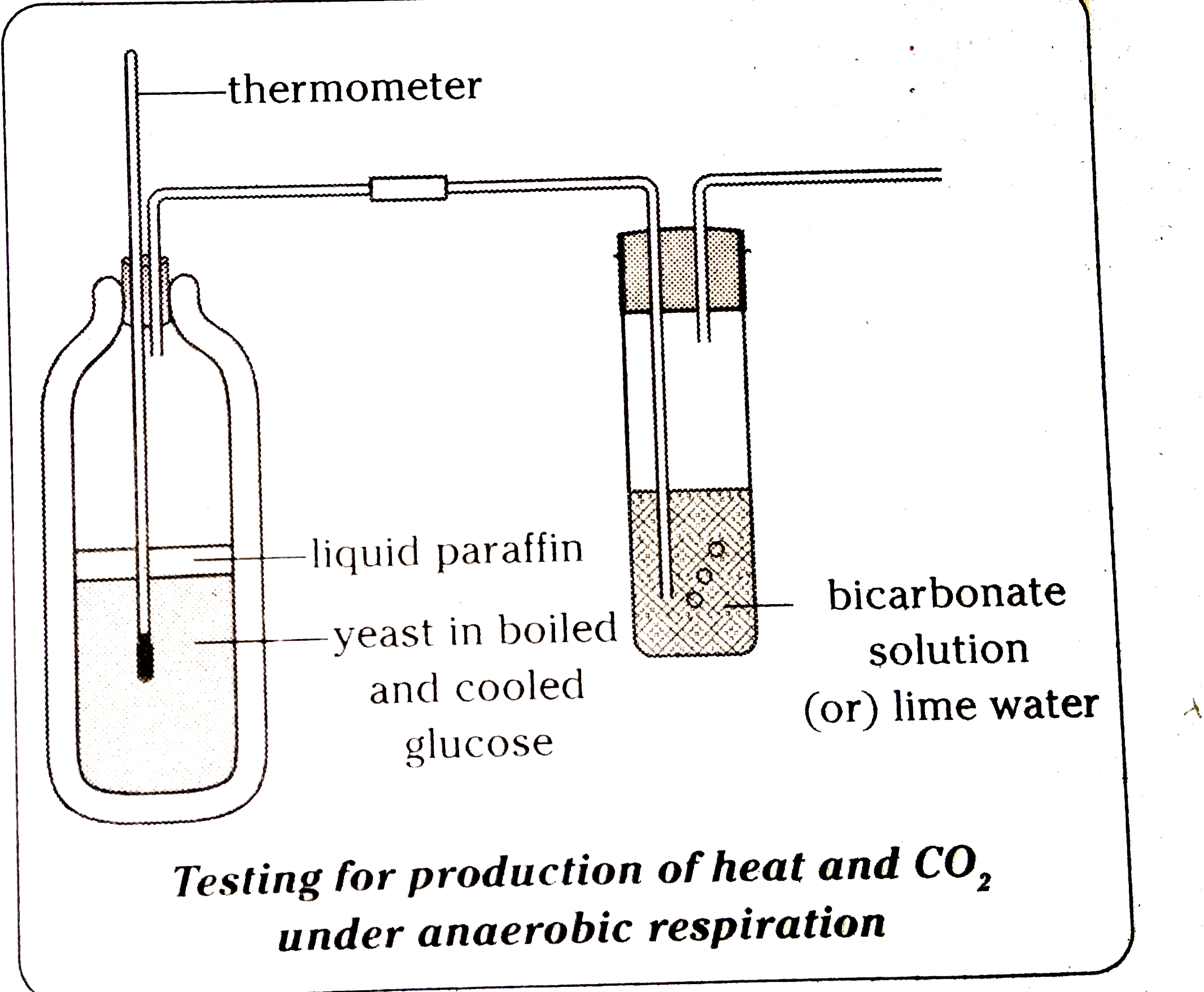What procedure do you follow to understand anaerobic respiration in your school laboratory ? Solution in Telugu
Aim:To prove that CO2 is released during anaerobic respiration .
Apparatus : Thermos flask , splitted corks , thermometer , wash bottle, glass tubes , liquid paraffin, glucose solution , yeast cells , bicarbonate solution, Janus Green B solution.
Procedure :
(1)Heat the glucose solution in a beaker , pour it in a thermos flask
(2)To remove dissolved oxygen from glucose solution by boiling it in thermos flask for a minute and then cooling it without shaking.
(3)Now add some yeast to the glucose solution and fix two-holed rubber stopper to the flask .
(4)The supply of oxygen from the air can be cut off by pouring a 1 cm layer of liquid paraffin on the mixture (Thermos is heat resistant can't be used for boiling).
(5)Insert one end of the thermometer into the thermos flask. See the end of thermometer kept inside the solution.
(6)Arrange for any gas produced by the yeast to escape through a wash bottle containing bicarbonate solution or lime water as shown in the figure.
(7)Add a few drops of diazine green (Janus Green B) solution to the yeast suspension before you pour liquid paraffin over it.
(8)The blue diazine green solution turns pink when oxygen is in short supply around it .
(9)Warm the apparatus to about 37∘ F in order to speed up the test . (If you do experiment in test tube).
(10)Keep the apparatus undisturbed for one or two days
Observations :
(1)After two days if can be observed that lime water of the wash bottle turns into milky white precipitate.
(2)Increase in the temperature noted on yeast cells respire and release energy .
(3)Alcohol smell given off from the flask.
Result : These observations indicate that yeast cells respire anaerobically converting glucose solution into CO2 , ethyl alcohol and releasing heat energy .

Topper's Solved these Questions
- RESPIRATION - THE ENERGY PRODUCING SYSTEM Book:VGS PUBLICATION-BRILLIANTChapter:RESPIRATION - THE ENERGY PRODUCING SYSTEM Exercise:IMPROVE YOUR LEARNING (INFORMATION SKILLS AND PROJECTS)
Explore 3 Videos
- RESPIRATION - THE ENERGY PRODUCING SYSTEM Book:VGS PUBLICATION-BRILLIANTChapter:RESPIRATION - THE ENERGY PRODUCING SYSTEM Exercise:IMPROVE YOUR LEARNING (COMMUNICATION THROUGH DRAWING , MODEL MAKING )
Explore 2 Videos
- RESPIRATION - THE ENERGY PRODUCING SYSTEM Book:VGS PUBLICATION-BRILLIANTChapter:RESPIRATION - THE ENERGY PRODUCING SYSTEM Exercise:IMPROVE YOUR LEARNING (ASKING QUESTION AND MAKING HYPOTHESIS)
Explore 3 Videos
- RESPIRATIONBook:VGS PUBLICATION-BRILLIANTChapter:RESPIRATIONExercise:EXERCISE
Explore 328 Videos
- SAVIOURS OF OUR ENVIRONMENTBook:VGS PUBLICATION-BRILLIANTChapter:SAVIOURS OF OUR ENVIRONMENTExercise:Fill in the blanks
Explore 15 Videos
Similar Questions
Collect information about cutaneous respiration in frog. Prepare a note and explain them in your classroom.
View SolutionWhat is the pathway of air from nostril to alveolus ?
View SolutionWhat will happen, if there is no diaphragm in the human body?
View SolutionDistinguish between Inspiration and Expiration
View SolutionFill in the blank.
(1) ………………… is a concern for the preservation, restoration and improvement of the natural and social environment.
View Solutionकोशिकीय श्वसन से आप क्या समझते हैं?
View Solutionसोडियम-पोटेशियम पम्प से आप क्या समझते हैं? इसकी क्रियाविधि को स्पष्ट कीजिए।
View Solutionअनॉक्सी या आवयवीय (anaerobic) श्वसन से आप क्या समझते है?
View SolutionWhat experiment do you perform to understand action of saliva on flour ? Explain It's procedure and apparatus that you followed .
View Solutionजीवद्रव्यी श्वसन से आप क्या समझते है ?
View Solutionबफर विलयन से क्या समझते हो ? ये कितने प्रकार के होते है ? क्रियाविधि सहित स्पष्ट कीजिए।
View Solutionजीवद्रव्यी श्वसन से आप क्या समझते हैं?
View Solutionजीवद्रव्यी श्वसन से आप क्या समझते हैं?
View SolutionWhat is fermentation ? Why anaerobic respiration should not be used as synonym of fermentation ?
View SolutionDescribe the procedure you used in your school laboratory to examine the carbs in the leaves
View Solution

